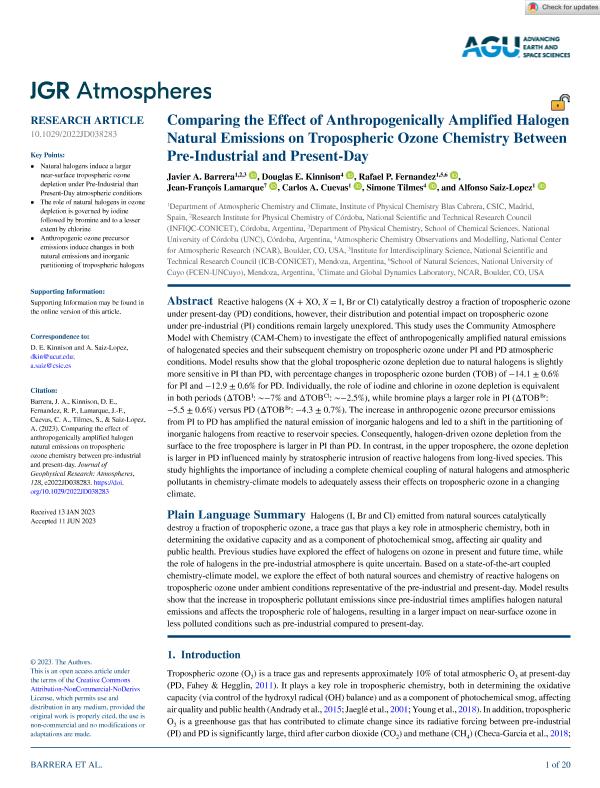Artículo
Comparing the Effect of Anthropogenically Amplified Halogen Natural Emissions on Tropospheric Ozone Chemistry Between Pre-Industrial and Present-Day
Barrera, Javier Alejandro ; Kinnison, Douglas E.; Fernandez, Rafael Pedro
; Kinnison, Douglas E.; Fernandez, Rafael Pedro ; Lamarque, Jean François; Cuevas, Carlos Alberto; Tilmes, Simone; Saiz López, Alfonso
; Lamarque, Jean François; Cuevas, Carlos Alberto; Tilmes, Simone; Saiz López, Alfonso
 ; Kinnison, Douglas E.; Fernandez, Rafael Pedro
; Kinnison, Douglas E.; Fernandez, Rafael Pedro ; Lamarque, Jean François; Cuevas, Carlos Alberto; Tilmes, Simone; Saiz López, Alfonso
; Lamarque, Jean François; Cuevas, Carlos Alberto; Tilmes, Simone; Saiz López, Alfonso
Fecha de publicación:
06/2023
Editorial:
Wiley
Revista:
Journal of Geophysical Research: Atmospheres
ISSN:
2169-897X
e-ISSN:
2169-8996
Idioma:
Inglés
Tipo de recurso:
Artículo publicado
Clasificación temática:
Resumen
Reactive halogens (X + XO, X = I, Br or Cl) catalytically destroy a fraction of tropospheric ozone under present-day (PD) conditions, however, their distribution and potential impact on tropospheric ozone under pre-industrial (PI) conditions remain largely unexplored. This study uses the Community Atmosphere Model with Chemistry (CAM-Chem) to investigate the effect of anthropogenically amplified natural emissions of halogenated species and their subsequent chemistry on tropospheric ozone under PI and PD atmospheric conditions. Model results show that the global tropospheric ozone depletion due to natural halogens is slightly more sensitive in PI than PD, with percentage changes in tropospheric ozone burden (TOB) of −14.1 ± 0.6% for PI and −12.9 ± 0.6% for PD. Individually, the role of iodine and chlorine in ozone depletion is equivalent in both periods (ΔTOBI: ∼−7% and ΔTOBCl: ∼−2.5%), while bromine plays a larger role in PI (ΔTOBBr: −5.5 ± 0.6%) versus PD (ΔTOBBr: −4.3 ± 0.7%). The increase in anthropogenic ozone precursor emissions from PI to PD has amplified the natural emission of inorganic halogens and led to a shift in the partitioning of inorganic halogens from reactive to reservoir species. Consequently, halogen-driven ozone depletion from the surface to the free troposphere is larger in PI than PD. In contrast, in the upper troposphere, the ozone depletion is larger in PD influenced mainly by stratospheric intrusion of reactive halogens from long-lived species. This study highlights the importance of including a complete chemical coupling of natural halogens and atmospheric pollutants in chemistry-climate models to adequately assess their effects on tropospheric ozone in a changing climate.
Palabras clave:
Halogens
,
Ozone
,
Pre-Industrial and Present-Day
,
CAM-Chem
Archivos asociados
Licencia
Identificadores
Colecciones
Articulos(ICB)
Articulos de INSTITUTO INTERDISCIPLINARIO DE CIENCIAS BASICAS
Articulos de INSTITUTO INTERDISCIPLINARIO DE CIENCIAS BASICAS
Articulos(INFIQC)
Articulos de INST.DE INVESTIGACIONES EN FISICO- QUIMICA DE CORDOBA
Articulos de INST.DE INVESTIGACIONES EN FISICO- QUIMICA DE CORDOBA
Citación
Barrera, Javier Alejandro; Kinnison, Douglas E.; Fernandez, Rafael Pedro; Lamarque, Jean François; Cuevas, Carlos Alberto; et al.; Comparing the Effect of Anthropogenically Amplified Halogen Natural Emissions on Tropospheric Ozone Chemistry Between Pre-Industrial and Present-Day; Wiley; Journal of Geophysical Research: Atmospheres; 128; 14; 6-2023; 1-20
Compartir
Altmétricas



